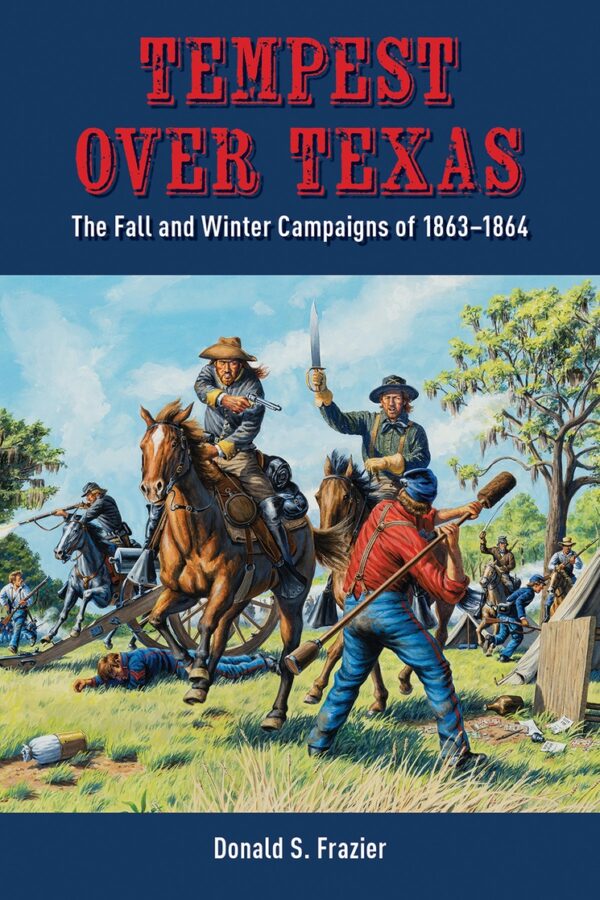Tempest Over Texas: The Fall and Winter Campaigns of 1863-1864 by Donald S. Frazier. State House Press, 2020. Cloth, ISBN: 978-1-933337-83-8. $39.95.
 For the past quarter century, Donald S. Frazier, currently the Director of the Texas Center at Schreiner University, has been writing innovative studies about the U.S. Civil War. Frazier’s first book, Blood and Treasure: Confederate Empire in the Southwest (1995) examined Confederate pursuit of empire and anticipated the recent wave of attention to this topic among scholars. His main project for some time, the Louisiana Quadrille, was originally intended to be a series of four books offering fine-grained analysis of Texas and Louisiana’s experiences during the conflict. The first three volumes, Fire in the Cane Field: The Federal Invasion of Louisiana and Texas, January 1861–January 1863 (2009), Thunder Across the Swamp: The Fight for the Lower Mississippi, February–May 1863 (2011), and Blood on the Bayou: Vicksburg, Port Hudson, and the Trans-Mississippi (2015), carried the narrative through the summer of 1863. With the publication of Tempest Over Texas, which takes the narrative to early 1864, it seems that the Louisiana Quadrille may become the Louisiana Pentadrille. The final volume will likely focus on the 1864 Red River Campaign and aftermath.
For the past quarter century, Donald S. Frazier, currently the Director of the Texas Center at Schreiner University, has been writing innovative studies about the U.S. Civil War. Frazier’s first book, Blood and Treasure: Confederate Empire in the Southwest (1995) examined Confederate pursuit of empire and anticipated the recent wave of attention to this topic among scholars. His main project for some time, the Louisiana Quadrille, was originally intended to be a series of four books offering fine-grained analysis of Texas and Louisiana’s experiences during the conflict. The first three volumes, Fire in the Cane Field: The Federal Invasion of Louisiana and Texas, January 1861–January 1863 (2009), Thunder Across the Swamp: The Fight for the Lower Mississippi, February–May 1863 (2011), and Blood on the Bayou: Vicksburg, Port Hudson, and the Trans-Mississippi (2015), carried the narrative through the summer of 1863. With the publication of Tempest Over Texas, which takes the narrative to early 1864, it seems that the Louisiana Quadrille may become the Louisiana Pentadrille. The final volume will likely focus on the 1864 Red River Campaign and aftermath.
In a review of Blood on the Bayou (also published on this website), I observed that Frazier’s treatment of August 1863 – February 1864 was somewhat cursory, and expressed my hope that he would deal with the period in greater depth in a subsequent volume. On this score, Tempest Over Texas does not disappoint. Frazier provides a detailed narrative about Texas and Louisiana—not to mention how the French Intervention in Mexico and decisions in Washington, D.C., influenced the course of events in these states.
Frazier has an eye for good quotes, as evidenced by his inclusion of the story of an Ohio German artilleryman. When a Texan commanded this artilleryman, at gunpoint, to halt and surrender, the gunner “spun around and knocked him [the Texan] on the head with his rammer” (286) and told his would-be captor to go to hell. Frazier’s bibliography demonstrates that he mined numerous manuscript collections, government documents, and newspapers; he also has a thorough command of the historiography. Like the other volumes in the Louisiana Quadrille, Tempest Over Texas is lavishly illustrated and contains dozens of illustrations and maps.
Frazier registers one perennial lament about the study of the U.S. Civil War: namely, scholarly attention to the three theaters – Eastern, Western, and Trans-Mississippi – has always been uneven. The fact that the Eastern Theater receives the lion’s share of attention has long irritated scholars of the Western and Trans-Mississippi Theaters. The author seems somewhat skeptical that people interested in the other two theaters will read this book, but he contends that they should. It is hard to disagree with this point. The sheer breadth of the conflict in Texas and Louisiana means that it would be difficult not to find something in this volume that interests everyone. Indeed, the Trans-Mississippi Theater saw “international intrigue and geopolitical brinksmanship” as well as “diplomats, revolutionaries, deserters, and soldiers,” not to mention “the ever-present questions of race and the fate of emancipated slaves,” and “Unionist dissent behind Confederate lines” (2).
On that note, there are many reasons why people should consider purchasing and reading Tempest Over Texas. For one, Frazier’s careful attention to the transnational elements of the U.S. Civil War. The volume does not begin with General Nathaniel P. Banks planning out potential campaigns in Texas and Louisiana. Nor does it open with Generals Richard Taylor and John B. Magruder’s attempts to halt U.S. armies. It begins with another general, Ignacio Zaragoza, in a city far south of Texas and Louisiana – Puebla, Mexico – and Zaragoza’s stunning victory over the French on May 5, 1862. From the beginning, Frazier correctly insists that any study of the U.S. Civil War during this period should pay close attention to events in Mexico. As the French and the Mexican Conservatives pushed the Liberals out of Mexico City and closer to the border, new opportunities opened up for potential collaboration between U.S. soldiers, civilians, and Liberals on the one hand and the Confederates, the French, and Mexican Conservatives on the other. Frazier discusses the passage of cotton through Matamoros and how some Mexican ports could become arteries that supplied rebels in the Trans-Mississippi. Abraham Lincoln and Henry W. Halleck pressed Nathaniel P. Banks to invade Texas to ensure that Confederates and the French saw the U.S. flag.
For their part, French behavior often threw U.S. and rebel authorities for a loop. For example, on September 26, 1863, the steamer Love Bird anchored off Matamoros with a cargo of 10,000 Enfield rifle-muskets, 156 pistols, two million rounds of ammunition, and five million percussion caps. General Hamilton P. Bee began unloading the weapons but, suddenly, the French warship Panamaseized the ship in the name of Emperor Napoleon III. The French Emperor and many of his ministers clearly sympathized with the rebel cause and worried that a U.S. victory would threaten their flagrant violation of the Monroe Doctrine. Why stop the weapons? Because, Frazier explains, the French worried that some of the guns would end up in the hands of the Liberals. Events never occur in a vacuum, and Frazier correctly argues that students of the U.S. Civil War need to consider the world beyond the borders of the U.S.
Frazier also devotes significant time to politics. As noted above, Lincoln and Halleck prodded Banks to invade Texas for eminently political reasons. However, just about the time Banks did invade the Lone Star State, the president and the general-in-chief altered their thinking and no longer wanted Banks in Texas. Although a former Speaker of the U.S. House of Representatives and Governor of Massachusetts, Banks sometimes seemed to lack political acumen, failed to grasp what Lincoln and Halleck wanted him to do, and, like many of his fellow generals, dithered and delayed. That said, Frazier notes that, while researching and writing the Quadrille, he grew to appreciate Banks and, for that matter, “anyone who has had thatboss may come to appreciate General Banks in new ways” (3). There are numerous times in this volume when it is very hard not to pity Banks. He had a herculean task and insufficient manpower. External events—also dictated by politics—likewise worked against Banks. Once Vicksburg and Fort Hudson fell, Lincoln jubilantly proclaimed that “the Father of Waters again goes unvexed to the sea.” However, rebels frequently harried shipping, and Banks had to work with other military and naval commanders to protect the river, which bled manpower. He also had to hold and occupy territory gained in Louisiana while planning an invasion of Texas.
Anyone interested in the intertwined questions of loyalty and dissent will appreciate Frazier’s close attention to how civilians behaved in the face of occupations. Moreover, Frazier explores many different types of dissent among Unionists in Louisiana and Texas – from Ozémé Carriêre’s armed band the Clan to the peregrinations of Dennis Haynes.
As one would expect, this book also addresses emancipation and the search for African American soldiers. Frazier builds on his analysis in Blood on the Bayou about how the movement of armies often resulted in the movements of people, both free and enslaved, as well as how armies searched for and attempted to exert control over African American bodies. When U.S. commanders planned out their movements, they thought about areas that might have large populations of enslaved people that they could seize and enroll in the army. Rebels, in turn, constantly relocated their slaves, which helped destabilize the peculiar institution. Here, it would have been helpful if Frazier had sought out additional sources such as the WPA narratives or pension records. This would have allowed him to include more African American voices and firsthand perspectives from enslaved people about the arrival of U.S. armies, civil/military relations, and how black soldiers began to change white people’s conceptions of African American capabilities as well as their understandings of citizenship.
Finally, one of the volume’s main draws is Frazier’s comprehensive analysis of military affairs in Texas and Louisiana. Without doubt, all the volumes in the Quadrille offer unrivaled and exceptionally close detail about the movement of armies and the engagements in this theater. As one would expect, Tom Green, Edmund Kirby Smith, Richard Taylor, Nathaniel P. Banks, William B. Franklin, and Charles P. Stone play outsized roles in this volume. That said, Frazier includes numerous accounts from common soldiers about battles, occupations, marching, foraging, and other aspects of army life. This volume does not feature many major engagements, but it does showcase a number of hard-fought smaller battles and skirmishes. Frazier also makes a good point that, after the disaster at Chickamauga, Lincoln and Halleck bled as many troops out of the Trans-Mississippi as they could—and thus made Banks’s task all the more difficult. Taylor and Green had some successes in Louisiana, but Taylor had a difficult time deciphering what Banks planned to do next. In fact, Taylor moved men all over the theater—often to no effect—which caused grumbling among his soldiers about “Mudwall Jackson’s grand strategic movement” (163). In Louisiana, Franklin advanced and then retreated. U.S. forces clawed away some portions of the Texas coast from the rebels but, by early 1864, Union policymakers wanted U.S. troops out of Texas. Banks began to prepare for a move up the Red River, which is where this volume ends.
In sum, Tempest Over Texas offers a fine-grained account of a six-month period in a theater that most people do not know very much about. In addition to covering military affairs, Frazier offers sound analysis of international affairs, politics, and emancipation. Anyone interested in the U.S. Civil War would do well to read this volume.
Evan C. Rothera is Assistant Professor of History at the University of Arkansas – Fort Smith. He is co-editor of The War Went On: Reconsidering the Lives of Civil War Veterans, and author of a forthcoming monograph on civil wars and reconstructions in the U.S., Mexico, and Argentina.
